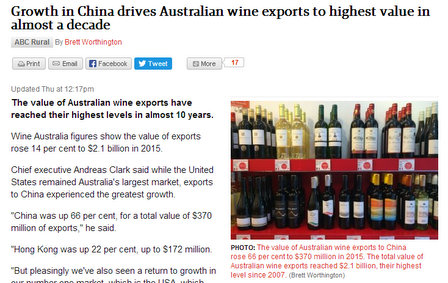All the wine world’s a stage and China keeps getting bigger roles. Some press coverage of that drama. By J. Boyce

Australia has just seen its highest export sales in a decade, reaching 2.1 billion dollars in 2015, and China played a strong role in that rise, reports ABCÂ here:
[Wine Australia] chief executive Andreas Clark said while the United States remained Australia’s largest market, exports to China experienced the greatest growth.
“China was up 66 per cent, for a total value of $370 million of exports,” he said.
“Hong Kong was up 22 per cent, up to $172 million.
ABC also reported that Anne Ruston, Assistant Agriculture Minister, stated the growth came before passing of the recent China-Australia free trade agreement:
“The fact that Australia’s strongest export growth was recorded in to China, and the new ChAFTA effects are not yet reflective in Wine Australia’s figures really does indicate that we are in the midst of yet another boost in market optimism,” she said in a statement.
“Under ChAFTA, the tariff on bulk has already reduced from 20 per cent to 12 per cent, and the tariff on bottled wine has reduced from 14 per cent to 8.4 per cent.”
Not mentioned by ABC, but pointed out by Philip White in this In Daily post called “The truth behind the latest wine export figures”, is how a weak Australian dollar helped. I dug up the last two years of CNY-AUD exchange rates and the visual is striking:
White breaks down the export numbers in more detail, and looks at the role played by premium brands, in a semi-rant that is well worth reading. Check it out here.
Georgia, with thousands of years of wine-making history under its belt, is about to open its newest wine center in China, says Tbilsi-based site Agenda:
Georgia’s Agriculture Ministry announced the wine centre will be opened in February this year in China’s province Jiangxi where about 30 million people live. A Georgian wine centre will cover 4,000 sq.m. territory where will be placed wine-testing and exhibition halls, museum, Georgian restaurant, etc. This will be the fifth Georgian wine centre to be opened in China.
Agenda notes that Georgia has opened venues in Beijing, in Zhejiang province and in the Xinjiang region. Georgia has also been active at recent trade fairs in China.
Kendall-Jackson has turned a new leaf in China by switching importers. One month after ASC Fine Wines announced, in this terse statement, its parting with Jackson Family Wines, competitor Summergate, which seems to have been buoyed after being acquired by Woolworths just over a year ago, announced it has partnered with this well-known California operation. From this Summergate press release:
After several months of discussions and joint planning, Summergate and Jackson Family Wines (JFW) today announced a successful multi-year partnership for the Greater China market for Kendall-Jackson wines. Effective immediately Summergate has been appointed the sole importer and distributor for this iconic American wine producer across the region – Hong Kong, Macau, and Mainland China. Summergate expects to have Kendall-Jackson wines available in all major cities across Mainland China in the Spring of 2016, and even sooner in Hong Kong and Macau.
Summergate also lists the U.S. brands Black Stallion, Brazin, Delicato, Gnarly Head, Ingelnook, Irony, J. Christopher, Kistler, Ridge, Tablas Creek and Woodhaven.
Check out the new online China Wine Directory. And get the free Grape Wall e-newsletter by signing up below.